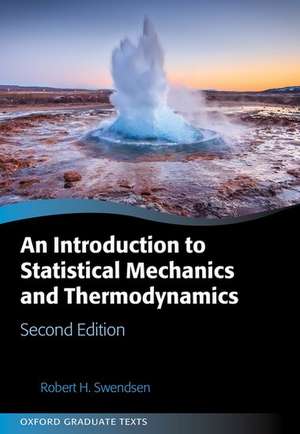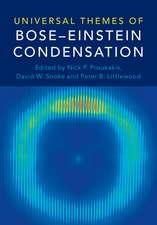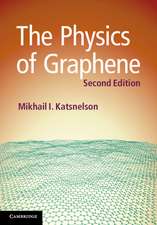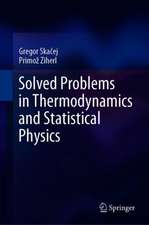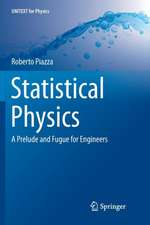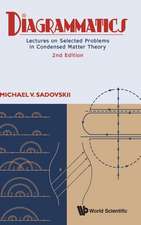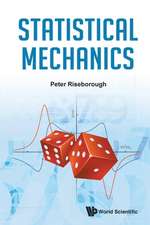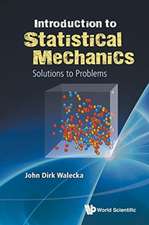An Introduction to Statistical Mechanics and Thermodynamics: Oxford Graduate Texts
Autor Robert H. Swendsenen Limba Engleză Hardback – 10 dec 2019
| Toate formatele și edițiile | Preț | Express |
|---|---|---|
| Paperback (1) | 289.57 lei 10-16 zile | +63.90 lei 4-10 zile |
| OUP OXFORD – 22 aug 2024 | 289.57 lei 10-16 zile | +63.90 lei 4-10 zile |
| Hardback (2) | 470.18 lei 10-16 zile | |
| Oxford University Press – mar 2012 | 470.18 lei 10-16 zile | |
| OUP OXFORD – 10 dec 2019 | 485.10 lei 10-16 zile | +101.57 lei 4-10 zile |
Din seria Oxford Graduate Texts
- 16%
 Preț: 734.52 lei
Preț: 734.52 lei - 8%
 Preț: 289.57 lei
Preț: 289.57 lei - 18%
 Preț: 511.25 lei
Preț: 511.25 lei - 18%
 Preț: 338.80 lei
Preț: 338.80 lei - 8%
 Preț: 322.49 lei
Preț: 322.49 lei - 6%
 Preț: 337.03 lei
Preț: 337.03 lei - 8%
 Preț: 255.35 lei
Preț: 255.35 lei - 13%
 Preț: 476.30 lei
Preț: 476.30 lei - 10%
 Preț: 246.92 lei
Preț: 246.92 lei - 8%
 Preț: 324.87 lei
Preț: 324.87 lei - 6%
 Preț: 312.46 lei
Preț: 312.46 lei -
 Preț: 313.13 lei
Preț: 313.13 lei - 29%
 Preț: 570.98 lei
Preț: 570.98 lei - 14%
 Preț: 500.83 lei
Preț: 500.83 lei - 8%
 Preț: 575.64 lei
Preț: 575.64 lei - 12%
 Preț: 483.43 lei
Preț: 483.43 lei - 14%
 Preț: 515.39 lei
Preț: 515.39 lei - 13%
 Preț: 291.53 lei
Preț: 291.53 lei - 9%
 Preț: 252.30 lei
Preț: 252.30 lei - 16%
 Preț: 432.56 lei
Preț: 432.56 lei -
 Preț: 307.25 lei
Preț: 307.25 lei - 10%
 Preț: 514.51 lei
Preț: 514.51 lei -
 Preț: 325.70 lei
Preț: 325.70 lei - 30%
 Preț: 638.98 lei
Preț: 638.98 lei - 15%
 Preț: 570.20 lei
Preț: 570.20 lei - 13%
 Preț: 364.82 lei
Preț: 364.82 lei - 15%
 Preț: 539.43 lei
Preț: 539.43 lei - 19%
 Preț: 445.59 lei
Preț: 445.59 lei - 14%
 Preț: 501.10 lei
Preț: 501.10 lei - 18%
 Preț: 334.57 lei
Preț: 334.57 lei - 11%
 Preț: 639.10 lei
Preț: 639.10 lei - 12%
 Preț: 323.61 lei
Preț: 323.61 lei - 28%
 Preț: 689.30 lei
Preț: 689.30 lei -
 Preț: 239.80 lei
Preț: 239.80 lei - 28%
 Preț: 638.42 lei
Preț: 638.42 lei - 18%
 Preț: 496.00 lei
Preț: 496.00 lei - 17%
 Preț: 509.94 lei
Preț: 509.94 lei - 15%
 Preț: 529.91 lei
Preț: 529.91 lei - 15%
 Preț: 573.87 lei
Preț: 573.87 lei - 15%
 Preț: 590.42 lei
Preț: 590.42 lei - 20%
 Preț: 538.22 lei
Preț: 538.22 lei - 17%
 Preț: 408.22 lei
Preț: 408.22 lei
Preț: 485.10 lei
Preț vechi: 589.72 lei
-18% Nou
Puncte Express: 728
Preț estimativ în valută:
92.84€ • 96.56$ • 76.64£
92.84€ • 96.56$ • 76.64£
Carte disponibilă
Livrare economică 14-20 martie
Livrare express 08-14 martie pentru 111.56 lei
Preluare comenzi: 021 569.72.76
Specificații
ISBN-13: 9780198853237
ISBN-10: 0198853238
Pagini: 496
Ilustrații: 28 b/w line illustrations
Dimensiuni: 175 x 252 x 29 mm
Greutate: 1.11 kg
Ediția:2
Editura: OUP OXFORD
Colecția OUP Oxford
Seria Oxford Graduate Texts
Locul publicării:Oxford, United Kingdom
ISBN-10: 0198853238
Pagini: 496
Ilustrații: 28 b/w line illustrations
Dimensiuni: 175 x 252 x 29 mm
Greutate: 1.11 kg
Ediția:2
Editura: OUP OXFORD
Colecția OUP Oxford
Seria Oxford Graduate Texts
Locul publicării:Oxford, United Kingdom
Recenzii
Review from previous edition In his innovative new text, Carnegie Mellon University physics professor Robert Swendsen presents the foundations of statistical mechanics with, as he puts it, a detour through thermodynamics. That's a desirable strategy because the statistical approach is more fundamental than the classical thermodynamics approach and has many applications to current research problems. [] The mathematical notation is carefully introduced and useful; the selected mathematical techniques are clearly explained in a conversational style that both graduate and advanced undergraduate students will find easy to follow. The author's subject organization and conceptual viewpoint address some of the shortcomings of conventional developments of thermal physics and will be helpful to students and researchers seeking a deep appreciation of statistical physics.
Bob Swendsen's book is very well thought out, educationally sound, and more original than other texts.
Robert Swendsen is a well-respected researcher who has developed many novel algorithms that illustrate his deep understanding of statistical mechanics. His textbook reflects his deep understanding and will likely have a major impact on the way statistical mechanics and thermodynamics is taught. Particularly noteworthy is Swendsen's treatment of entropy, following Boltzmann's original definition in terms of probability, and his comprehensive discussion of the fundamental principles and applications of statistical mechanics and thermodynamics. Students and instructors will enjoy reading the book as much as Swendsen obviously enjoyed writing it.
In this reader-friendly, excellent text, the author provides a unique combination of the best of two worlds: traditional thermodynamics (following Callen's footsteps) and modern statistical mechanics (including VPython codes for simulations).
Swendsen is famous for developing Monte Carlo algorithms which dramatically speed up the simulation of many systems near a phase transition. The ideas for those algorithms required deep understanding of statistical mechanics, an understanding which is now fully applied to this excellent textbook.
Bob Swendsen's book is very well thought out, educationally sound, and more original than other texts.
Robert Swendsen is a well-respected researcher who has developed many novel algorithms that illustrate his deep understanding of statistical mechanics. His textbook reflects his deep understanding and will likely have a major impact on the way statistical mechanics and thermodynamics is taught. Particularly noteworthy is Swendsen's treatment of entropy, following Boltzmann's original definition in terms of probability, and his comprehensive discussion of the fundamental principles and applications of statistical mechanics and thermodynamics. Students and instructors will enjoy reading the book as much as Swendsen obviously enjoyed writing it.
In this reader-friendly, excellent text, the author provides a unique combination of the best of two worlds: traditional thermodynamics (following Callen's footsteps) and modern statistical mechanics (including VPython codes for simulations).
Swendsen is famous for developing Monte Carlo algorithms which dramatically speed up the simulation of many systems near a phase transition. The ideas for those algorithms required deep understanding of statistical mechanics, an understanding which is now fully applied to this excellent textbook.
Notă biografică
Robert Swendsen received his BS from Yale and his PhD from the University of Pennsylvania. He did postdoctoral work at the Universität zu Köln, Germany, the Kernforschungsanlage in Jülich, Germany, and Brookhaven National Laboratory. From 1978 to 1984 he worked at the IBM Zurich Research Center. In 1984, he joined Carnegie Mellon University.He is a Fellow of both the American Physical Society and the American Association for the Advancement of Science. He was given an IBMOutstanding Achievement Award in 1981 and shared a Forefronts of Large-Scale Computational Problems Award with S. Kumar, J.M. Rosenberg, and P.A. Kollman in 1991. He was awarded the 2014 Aneesur Rahman Prize for Computational Physics and the 2014 Julius Ashkin Teaching Award in the Mellon College of Science at Carnegie Mellon University.
